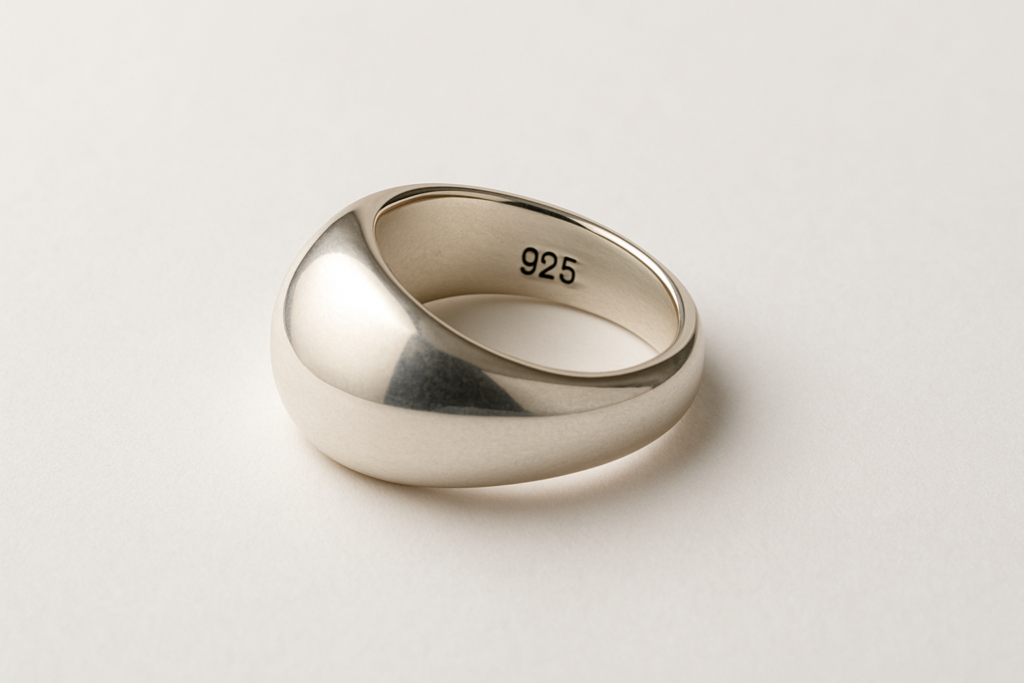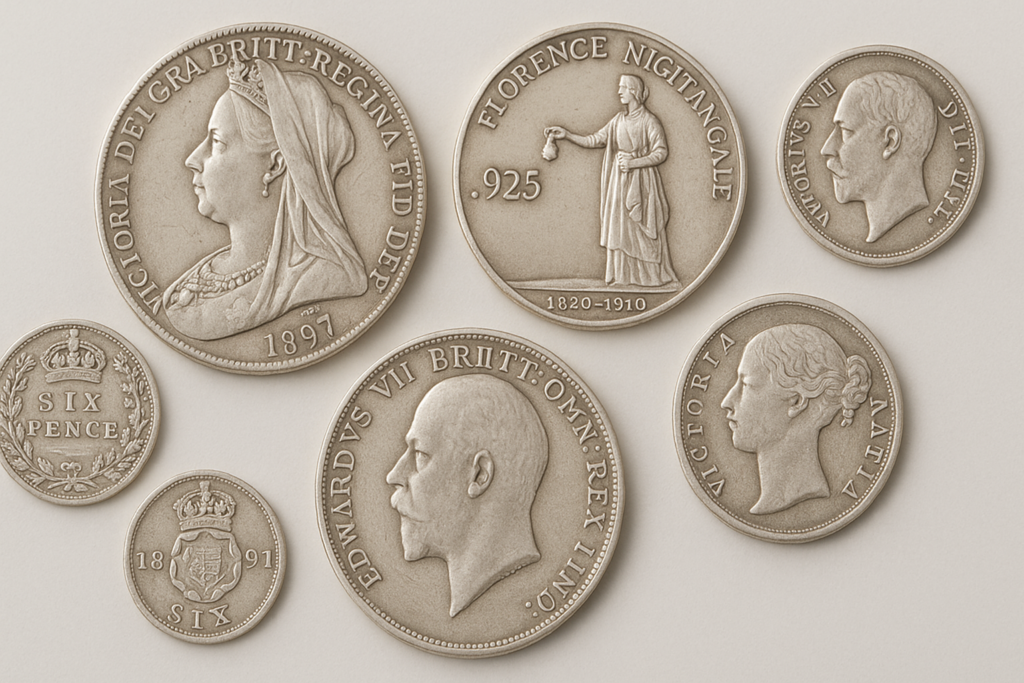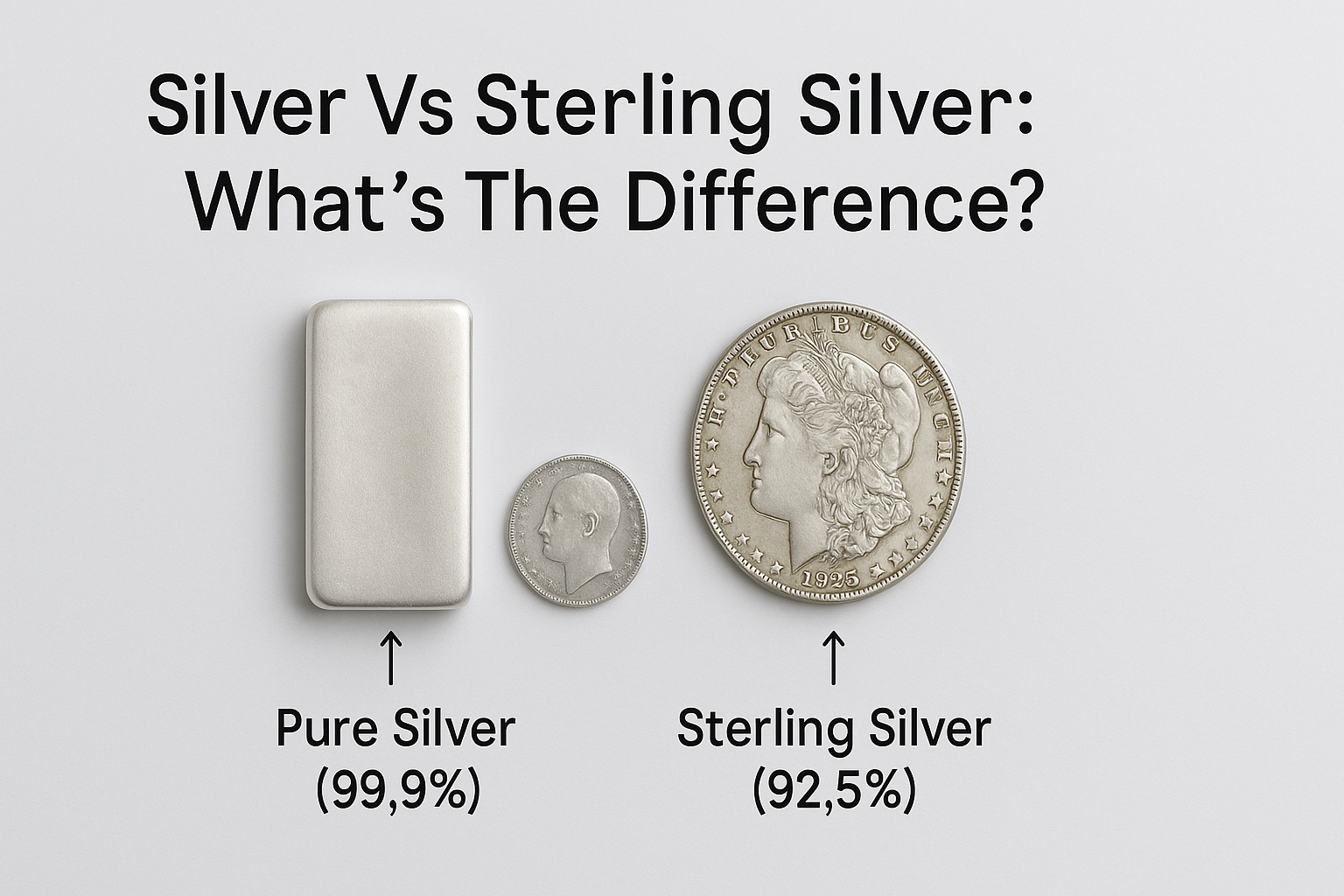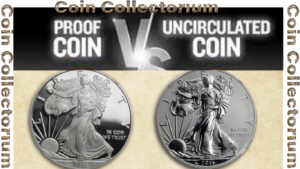Silver vs Sterling Silver, have you ever seen both while shopping and wondered what the difference is? At first glance, they both look like shiny, beautiful metal. But there’s more to it than just appearance.
Maybe you were buying a special gift, browsing coins or jewelry, or tagging along with someone else. Suddenly, you’re stuck thinking, “Wait… aren’t these the same thing?”
Whether you’re a curious shopper or a new collector, knowing the difference can save you time, money, and confusion.
So, what is the real difference between silver and sterling silver? Let’s break it down in simple terms.
Understanding Sterling Silver

Composition
Pure silver, the more expensive version, is simply silver. It’s not sterling silver, which is an alloy primarily made of silver.
Sterling silver has 92.5% silver by weight and some other metal makes up the remaining 7.5%. Typically, that 7.5% will be copper, although zinc is also widely used. There are a few other metals that can contribute to the 7.5% that I’ll cover.
Etymology
The term “sterling” is most probably derived from the Middle-English word “sterre”, which means “star,” perhaps from old Norman coins with stars on them. It first emerged in Europe at least in the 12th century, most likely in the region that is now modern-day Germany.
Different Application Contexts Of Sterling Silver
Although 7.5% additional materials in sterling silver may not seem like much, it does modify the conditions in which the metal can be used. Of course, in part due to the cost.
- In the past, sterling silver gained popularity in cutlery, especially after the Victorians were fixated on the idea of avoiding touching food with their hands.
- Nowadays, sterling silver can be found in jewelry, coinage, and in a variety of other miscellaneous items like letter openers and paper clips, as well as brasswind musical instruments including flutes and saxophones.
- Sterling silver has also been used in medical equipment since the Mesopotamians, most likely due to silver’s antimicrobial characteristics. This is the most plausible explanation for why people drop coins into fountains.
The Components Of Sterling Silver Alloy
Silver is not generally regarded as a reactive metal. Over a broad temperature range, it doesn’t react with oxygen to produce the silver oxide, which would be similar to iron rusting. It does interact with fossil fuel wastes, particularly sulfur, and can oxidize in the presence of ozone.
That’s fantastic; it means that silver tarnishes less than other metals, if not at all. But sterling silver is not all silver, it often contains 7.5% copper. The problem is that copper reacts with oxygen in the air. To combat this, sterling silver sometimes incorporates other metals like silicon or zinc.
The Durability Comparison
Silver is also regarded as a particularly soft metal. So having some non-silver in your silver objects has real advantages. The general consensus is that sterling silver is more resilient and durable than pure silver.
The Price Comparison
So, which one costs more? If you use silver in coinage, jewelry, or cutlery, you might be wondering which one will be easier on your wallet before you consider the metal’s qualities.
Sterling silver costs about $ 21.4939 per ounce and silver prices, as of this writing, cost roughly $23.2367 per ounce. The price of silver fluctuates quite a bit. However, if you want to compare it to gold, gold costs $1,839.30 per ounce, while platinum costs roughly $1,096.20.
Sterling Silver In Coinage
Even though the silver used in coinage is a different silver variety called “coin silver”, there are still some old and new coins made of sterling silver. Let’s talk about the ‘coin silver’ for a moment.

“Coin silver”
Coin silver is the kind of metal that is used to make silver dollars and some other forms of silver coinage, as its name implies. It is a standardized alloy made up of just a few non-silver metals, notably copper and nickel. Silver coins sold in the US must have a purity of at least .900. It must therefore include a minimum of 90% pure silver. It is far more valuable than other silver alloys that might contain additional metals in greater amounts.
But confusingly, some coins include sterling silver. The old British pound sterling is the most well-known example.
Obviously, sterling silver is not used to mint modern British pound coins. However, a vast range of other vintage objects, such as cutlery, serving platters, and containers, are made of this material.
A List Of The Most Popular Sterling Silver Coins
Many mints, including the Royal Mint, used sterling silver to fortify silver bullion, specifically silver coins. A silver coin with a purity of 92.5% was produced using a technique that combined pure silver with a little amount of some other metal (often copper), which was high enough to please investors and durable enough to prevent damage.
Here are some of the most popular sterling silver coins –
- 1473-7 Edward IV Hammered Silver Halfpenny – Second Reign
- 1625-49 Scottish Charles I Hammered Silver Twenty Pence
- 1707 Anne Crown
- 1887 Victoria Double Florin
- 1889 Victoria Jubilee Head Crown
- 1905 Edward VII Silver Sixpence
- 1920 Canada 25 Cent
- 1989 Elizabeth II 50 Cents – Masterpiece In Silver: Captain Cook Non-Circulating Coin
- 2020 – 2 Pounds – Elizabeth II – Florence Nightingale Commemorative Coin
Once upon a time, sterling silver was the pinnacle of coin production. However, today’s consumers demand items that are manufactured “to the max,” like most other things
This consumer attitude in the world of silver coinage is partly a result of the rise in silver bullion investors and collectors of fancy collectable coins. They hardly ever find something less than .999 pure silver sufficient to gratify their tastes.
Maintenance Of Sterling Silver Coins
Take the same care with your sterling silver coins that you would with any other historical coinage. Sterling silver coins tend to develop a patina, in part due to their alloys that contain copper. This appeals to some collectors, while others prefer to maintain their silver coins’ original white color.
Whatever the case, make sure to keep the sterling silver items in a dry, cool place. Ensure that they are not near sources of moisture, heat, or fumes.
Generally speaking, it is better to retain any coin in its original condition. So, let your sterling silver coins keep the coloring that develops naturally over time.
Conclusion
Since you now know what sterling silver is and the differences between sterling silver and pure silver, you’ll be able to make better decisions with far more clarity.
No matter what you prefer, your collection of sterling silver coins undoubtedly includes some of your most prized items. With the right care, they will last for years as beautiful additions to your coin collection as well as investment holdings.
FAQs
Is Sterling Silver The Same As Silver Coins?
No, sterling silver is not the same as regular (fine) silver or coin silver. Despite being close, sterling silver isn’t totally pure. A metal alloy is what sterling silver is known as. This means sterling silver is made of several different metals rather than just one solid metal.
The composition of sterling silver contains 92.5% silver and the rest 7.5% is another metal. Typically, this 7.5% is either copper or zinc. These other metals provide sterling silver with a significant strength and durability boost.
As a result, it becomes easier to make a variety of other items, such as jewelry, silverware, silver-plated objects, etc.
Is Sterling Silver As Valuable As Silver?
Pure silver is more expensive than sterling silver because it contains more silver. The metals used to make sterling silver alloys are not particularly valuable and don’t account for the metal’s overall worth. However, the price difference is minor.
So, does sterling silver have any substantial value? If we’re referring to the real stuff – yes, it does.
Sterling silver, which is 92.5% pure silver, is fairly valuable. Owning genuine sterling silver is remarkable because pure silver is thought to be among the precious metals found on Earth.
The catch is – sterling silver is not so cheap, so if you are offered a sterling silver coin or jewelry that is apparently stamped with the 92.5% purity mark for a low price, you should leave.
Is Sterling Silver A High-Quality Metal?
Certainly, it is. Sterling silver has been the purest kind of silver used in coinage, cutlery, and other expensive items for ages. It combines beauty and strength.
Furthermore, almost all other high-quality silver produced throughout the 19th and late 20th centuries had only 90% purity, as opposed to sterling silver, which is .925 fine, meaning 92.5% pure.
Which Is Better: Sterling Silver Or Silver?
This question doesn’t have an absolute answer. Sterling silver, in the opinion of many, is the most attractive and practical type of silver. Others might like silver items with lower purity levels, 90% pure silver coins, or 99.9% pure silver bullion. It depends on personal preference and taste.
In a nutshell, sterling silver would be the ideal option in terms of practicality. The alloy’s strong metals make any item durable and long-lasting. That is, assuming you provide it with the necessary maintenance.
Sterling silver jewelry offers more alternatives than other types of silver jewelry. This is because there are more designs possible owing to its increased durability and ease of shaping.
Does Sterling Silver Damage Easily?
When exposed to strong chemicals like household bleach, chlorine, sulfur, humidity, grease, cosmetics, and salty air, sterling silver tarnishes. I suggest you keep your sterling silver in a stable, dry location when performing the following activities to minimize tarnish –
- Carrying out outdoor and indoor chores
- Taking a shower, bathing, or swimming in hot springs, pools, hot tubs, or the ocean
- Using cosmetics like lotion, hair products, and perfumes
- Working out in a gym or while playing contact sports
- Preparing food
Meta:
It’s time for the Silver vs. Sterling Silver debate. This article addresses their key differences, unique qualities, popular uses, and care tips.


![Read more about the article How To Clean Antique Gold Coins Safely [Should You?]](https://coincollectorium.com/wp-content/uploads/2025/06/Antique-Gold-Coins-300x194.jpg)

